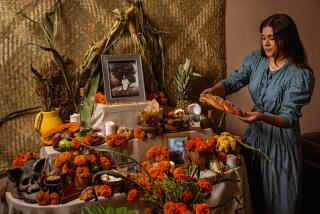. . . and the Comforts of a Peaceful <i> Parador</i>
- Share via
CARMONA, Spain — In the pre-dawn darkness far below the crumbling Moorish walls that house Carmona’s parador, Alcazar del rey Don Pedro, the dogs and cattle and cocks announce the dawn as they have for centuries.
From the terrace of my room early last October, I watched a sunrise breaking over the plains where the Roman general, Scipio, crushed the Carthaginians in 206 BC.
Lights from distant farming villages have disappeared, and a thick, ghostly mist has faded into an endless rolling field of golden Andalusian soil.
Hundreds of feet below, the squat white farmhouses and wandering fences of cacti slowly become discernible. A dark figure on a donkey moves up the steep winding path toward this fortress hill-town of Carmona on a summit above the plain.
He shouts a greeting to a goat herder taking his flock down the twisting path toward the fields.
Far away, droning trucks roll down the highway that joins Seville to Cordoba. Donkeys bray, cattle bawl and the sun opens another day on the town that claims the oldest continuous population in Europe.
Carmona is listed briefly, if at all, in most travel guides, and doesn’t get to see many tourists.
Those who do visit will find that a sense of history, stacked layer upon layer, pervades everything. Appropriately, what may be the oldest calendar in Spain is carved into a 6th-Century arch in the Patio de los Naranjos of the Gothic priory of Santa Maria.
Townspeople are warm and generous if there is a reason to encounter an outsider, but generally prefer to get on with their daily routines and ignore travelers.
The first prehistoric inhabitants of Spain settled on this hilltop 500,000 years ago. Carmona, a Spanish National Monument, was the site of a rich Targessian city where Phoenician emigrants settled, and where Romans later built the fortifications of Carmo, a colony on the famous Via Augusta that joined southern ports to the north of Spain.
Carmona was the favorite residence of the Moorish king, Pedro the Cruel. Queen Isabella later lived here while conducting the campaign against Granada.
Because of its impregnable position on the flat-topped hill above the plain, Carmona has never been conquered.
Two main roads lead up and through the Old Town walls into the city, one from Cordoba through a majestic Roman gate refurbished in the 17th Century, and from Seville through a gate built by the Carthaginians and embellished by the Moors.
The spires of ancient churches reach to the sky above the dazzling white walls of the ageless houses, some of them ancestral homes of Spanish nobility.
In the maze of medieval cobblestone streets the present occupants carry on the unhurried life of a Spanish village.
Women in black scrub the streets in front of their houses as youngsters on mopeds streak past. Old men chatter or snooze in the sun on the benches of Plaza de San Fernando in the center of town.
Half a mile outside the old walls a 2,000-year-old Roman necropolis peacefully waits out the centuries. Carved into the stone of the hilltop, the crumbling family crypts show evidence of the frescoes that once adorned them, and still house the undisturbed terra-cotta boxes that hold the cremated remains of Carmona’s former residents.
A large tomb of a former governor is under reconstruction, and a friendly custodian will proudly give you a tour of the site and its small museum. Across the street lie the ruins of a Roman amphitheater.
The many dogs here seem to know who belongs and who doesn’t, treating tourists as nonentities.
One afternoon, heading back to my hotel with some of the delicious local cheeses and olives, I rounded a corner and saw a tour bus trapped in a tight turn of the narrow medieval street.
Residents deserted their siesta benches and ran to watch. The dogs yelped in approval. We all laughed and pointed and barked and slapped each other on the back.
The bus revved backward, forward, left a trail of twisted chrome, and then disappeared with a load of embarrassed tourists.
The town’s one hotel, the parador Alcazar del Rey Don Pedro, is one of the most comfortable and beautiful of the tourist facilities in the government’s parador chain.
Built into the ruins of the 14th-Century pleasure palace of King Pedro of Castile on the edge of the steep precipice, the hotel is an oasis in grand Andalusian style.
An open inner court, with a Moorish fountain and large pots of flowers, is perfect for sipping a fino regional sherry.
Just down the hill below the towering walls of the fortress-hotel is a lush pool and cabana area. The hotel restaurant serves classic Andalusian food, and 12 of the rooms have terraces with views. Request one when making reservations.
Taking a walk at dusk, when the sunset tints the rooftops and church spires with the same auburn gold as the soil of the countryside, I wandered into the once grand, now time-worn and neglected Iglesia de Santiago church, its air thick with history and ghosts.
A squat and cheerful caretaker rushed out of the darkness to flick on the lights, collected his tip, and disappeared.
Covered in dust as old as time itself, gaudy peeling saints peered down through the columns and darkness where conquistadors once prayed.
And one of the local musicians, who come to the church’s cool and quiet recesses to practice, began to strum and sing in high falsetto a haunting Gypsy song of love and faith and pain.
Near the main altar of this forgotten cathedral a life-size statue of the Virgin smiles softly into the darkness. A portion of her golden baroque halo is broken away and her rich gown is disintegrating into the past.
In addition to relaxing, tourists can wander the streets, visit the Roman ruins, shop and visit the cathedrals.
But like Spain itself, battered and worn by a turbulent history and moving optimistically toward the 21st Century without ever really joining the 20th, the sweet and ageless saint stares expectantly ahead into the future.
More to Read
Sign up for The Wild
We’ll help you find the best places to hike, bike and run, as well as the perfect silent spots for meditation and yoga.
You may occasionally receive promotional content from the Los Angeles Times.






